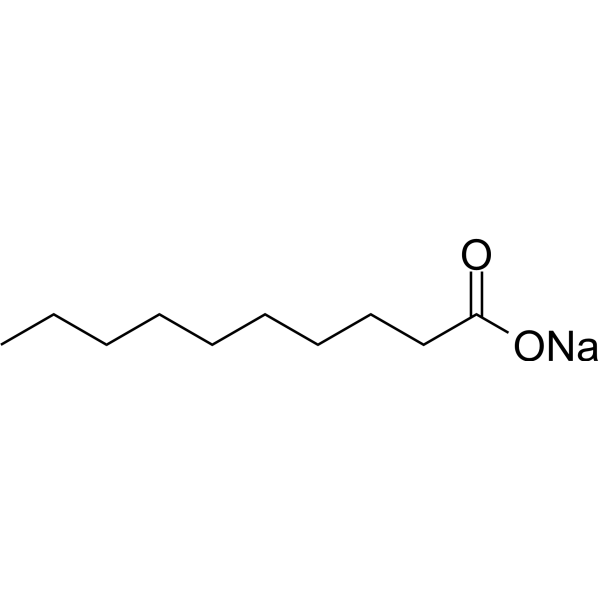
Sodium caprate
CAS No. 1002-62-6
Sodium caprate( Capric acid, sodium salt | Caprinic acid sodium salt | Decanoic acid, sodium salt | Sodium caprinate | Sodium decanoate | Sodium decanoic acid )
Catalog No. M27380 CAS No. 1002-62-6
Sodium decanoate is the sodium salt of caproic acid, a 10-carbon saturated fatty acid. It has an amphiphilic character and can form liquid crystalline phases and micelles in an aqueous solution.
Purity : >98% (HPLC)
 COA
COA
 Datasheet
Datasheet
 HNMR
HNMR
 HPLC
HPLC
 MSDS
MSDS
 Handing Instructions
Handing Instructions
| Size | Price / USD | Stock | Quantity |
| 1G | 26 | In Stock |


|
Biological Information
-
Product NameSodium caprate
-
NoteResearch use only, not for human use.
-
Brief DescriptionSodium decanoate is the sodium salt of caproic acid, a 10-carbon saturated fatty acid. It has an amphiphilic character and can form liquid crystalline phases and micelles in an aqueous solution.
-
DescriptionSodium decanoate is the sodium salt of caproic acid, a 10-carbon saturated fatty acid. It has an amphiphilic character and can form liquid crystalline phases and micelles in an aqueous solution.
-
In Vitro——
-
In Vivo——
-
SynonymsCapric acid, sodium salt | Caprinic acid sodium salt | Decanoic acid, sodium salt | Sodium caprinate | Sodium decanoate | Sodium decanoic acid
-
PathwayOthers
-
TargetOther Targets
-
Recptorinflammation|Antiviral
-
Research Area——
-
Indication——
Chemical Information
-
CAS Number1002-62-6
-
Formula Weight194.25
-
Molecular FormulaC10H19NaO2
-
Purity>98% (HPLC)
-
SolubilityIn Vitro:?H2O : 100 mg/mL (514.80 mM)
-
SMILES[Na+].CCCCCCCCCC([O-])=O
-
Chemical Name——
Shipping & Storage Information
-
Storage(-20℃)
-
ShippingWith Ice Pack
-
Stability≥ 2 years
Reference
1.Feng L, Sun Y, Song P, Xu L, Wu X, Wu X, Shen Y, Sun Y, Kong L, Wu X, Xu Q. Seselin ameliorates inflammation via targeting Jak2 to suppress the proinflammatory phenotype of macrophages. Br J Pharmacol. 2019 Jan;176(2):317-333. doi: 10.1111/bph.14521. Epub 2018 Dec 4. PMID: 30338847; PMCID: PMC6295420.
molnova catalog



related products
-
Auraptene
Auraptene is a coumarin derived from citrus plants that bears a geranyloxyl moiety at its C-7.
-
MS1943
MS1943 is a first-in-class, orally bioavailable EZH2 selective degrader, with an IC50 of 120 nM.
-
4-Chlorocinnamic aci...
4-Chlorocinnamic acid is a photosensitive compound. 2-Chlorocinnamic acid and 4-chlorocinnamic acid show potent urease inhibitory activities with the respective IC50 values of 0.66 and 1.10 uM.



 Cart
Cart
 sales@molnova.com
sales@molnova.com


